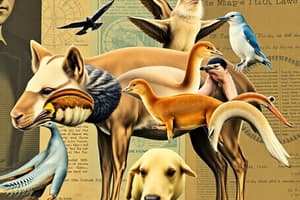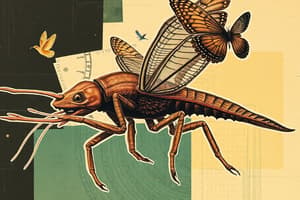Podcast
Questions and Answers
What type of reproduction is most commonly associated with complex animal groups?
What type of reproduction is most commonly associated with complex animal groups?
- Fragmentation
- Budding
- Asexual reproduction
- Sexual reproduction (correct)
Which of the following is NOT typically a focus of conservation zoology?
Which of the following is NOT typically a focus of conservation zoology?
- Protecting endangered species
- Enhancing reproductive mechanisms (correct)
- Addressing habitat loss
- Controlling threats to populations
What is a common characteristic of amphibians during their life cycle?
What is a common characteristic of amphibians during their life cycle?
- They possess dry skin with scales.
- They primarily live in marine environments.
- They breathe only through lungs throughout their life.
- They have aquatic larval stages. (correct)
Which of the following systems is primarily responsible for gas exchange in animals?
Which of the following systems is primarily responsible for gas exchange in animals?
Which group of animals is characterized by having mammary glands and hair?
Which group of animals is characterized by having mammary glands and hair?
What is zoology primarily concerned with?
What is zoology primarily concerned with?
Which system is used for the hierarchical classification of animals?
Which system is used for the hierarchical classification of animals?
What does animal anatomy study?
What does animal anatomy study?
In which type of habitat do animals NOT typically reside?
In which type of habitat do animals NOT typically reside?
What does animal ecology primarily focus on?
What does animal ecology primarily focus on?
Which concept is NOT central to evolutionary biology?
Which concept is NOT central to evolutionary biology?
What aspect of animal behavior does ethology study?
What aspect of animal behavior does ethology study?
Which of the following is a primary area of study in animal physiology?
Which of the following is a primary area of study in animal physiology?
Flashcards
Zoology Definition
Zoology Definition
Zoology is the study of animals, encompassing their behavior, interactions, and environments.
Animal Classification
Animal Classification
Categorizing animals based on shared traits like physical features, genetics, and evolutionary history.
Linnaean System
Linnaean System
A hierarchical system (kingdom, phylum, etc.) for classifying organisms.
Animal Diversity
Animal Diversity
Signup and view all the flashcards
Animal Anatomy
Animal Anatomy
Signup and view all the flashcards
Animal Physiology
Animal Physiology
Signup and view all the flashcards
Animal Behavior (Ethology)
Animal Behavior (Ethology)
Signup and view all the flashcards
Animal Ecology
Animal Ecology
Signup and view all the flashcards
Animal Evolution
Animal Evolution
Signup and view all the flashcards
Fossil Records
Fossil Records
Signup and view all the flashcards
Comparative Anatomy
Comparative Anatomy
Signup and view all the flashcards
Genetic Analysis
Genetic Analysis
Signup and view all the flashcards
Asexual Reproduction
Asexual Reproduction
Signup and view all the flashcards
Sexual Reproduction
Sexual Reproduction
Signup and view all the flashcards
Conservation Zoology
Conservation Zoology
Signup and view all the flashcards
Mammals
Mammals
Signup and view all the flashcards
Birds
Birds
Signup and view all the flashcards
Reptiles
Reptiles
Signup and view all the flashcards
Amphibians
Amphibians
Signup and view all the flashcards
Fish
Fish
Signup and view all the flashcards
Nervous System
Nervous System
Signup and view all the flashcards
Digestive System
Digestive System
Signup and view all the flashcards
Respiratory System
Respiratory System
Signup and view all the flashcards
Circulatory System
Circulatory System
Signup and view all the flashcards
Excretory System
Excretory System
Signup and view all the flashcards
Study Notes
Introduction to Zoology
- Zoology is the branch of biology that studies animals. It encompasses a vast array of topics, from the behavior of individual animals to the complex interactions between species and their environments.
Animal Classification
- Animals are classified into various groups based on shared characteristics. Key features used in classification include physical traits, genetic makeup, and evolutionary relationships.
- The Linnaean system provides a hierarchical framework (kingdom, phylum, class, order, family, genus, species) for classifying organisms.
- Modern classification often incorporates phylogenetic analysis to reflect evolutionary history more accurately than purely morphological characteristics.
Animal Diversity
- Animal diversity encompasses an astounding array of species with varied forms, functions, and ecological roles.
- Animals inhabit diverse environments, including terrestrial, aquatic (freshwater and marine), and aerial habitats.
- A wide range of adaptations enables animals to survive in these diverse settings.
Animal Anatomy and Physiology
- Anatomy focuses on the structure of animal bodies, examining organs, tissues, and cells.
- Physiology explores the functions of these structures, detailing processes like respiration, digestion, and reproduction.
- Comparative anatomy and physiology allow scientists to understand evolutionary relationships and adaptations across different animal groups.
Animal Behavior
- Animal behavior, or ethology, studies how animals interact with their environment and each other.
- This includes various aspects such as foraging strategies, mating rituals, communication systems, and social interactions.
- Behavioral patterns often highlight evolutionary adaptations optimizing survival and reproduction.
Animal Ecology
- Animal ecology examines the interactions between animals and their environments, including both biotic and abiotic factors.
- Topics explored in animal ecology range from population dynamics and community structures to the impact of climate change and human activities on animal populations.
- Understanding these intricate connections is crucial for effective conservation efforts.
Animal Evolution
- Evolutionary biology investigates the processes that have shaped animal diversity over time.
- Concepts such as natural selection, adaptation, and common ancestry are central to understanding the evolution of animal lineages.
- Fossil records, comparative anatomy, and genetic analysis provide valuable insights into the evolutionary history of animals.
Animal Reproduction
- Reproduction mechanisms are diverse across animal groups.
- Asexual reproduction, involving a single parent, exists in simpler animals, while sexual reproduction, involving two parents, is a more prevalent characteristic.
- Specialized reproductive structures and behaviors are often adapted for successful fertilization and offspring survival.
Animal Conservation
- Conservation zoology focuses on protecting endangered and threatened animal populations.
- This often entails addressing habitat loss, poaching, climate change, and pollution.
- Conservation strategies often involve protecting habitats, controlling threats to populations, and reintroducing species into their former environments.
Specific Animal Groups (Example)
- Mammals: characterized by mammary glands, hair, and three middle ear bones.
- Birds: distinguished by feathers, wings, and a beak.
- Reptiles: typically adapted for terrestrial environments, characterized by scales and dry skin. Many lay eggs.
- Amphibians: often have aquatic larval stages and transition to terrestrial adulthood. Often breathe through skin.
- Fish: aquatic vertebrates usually with fins, gills, and scales.
- Include several classes such as bony and cartilaginous fish.
Animal Physiology Specifics (Example)
- Nervous system function: communication and control mechanisms in animals
- Digestive system processes: breaking down and absorbing nutrients
- Respiratory systems: gas exchange (e.g., lungs, gills)
- Circulatory systems: transport of oxygen, nutrients, and waste products
- Excretory systems: removal of metabolic wastes
Studying That Suits You
Use AI to generate personalized quizzes and flashcards to suit your learning preferences.




